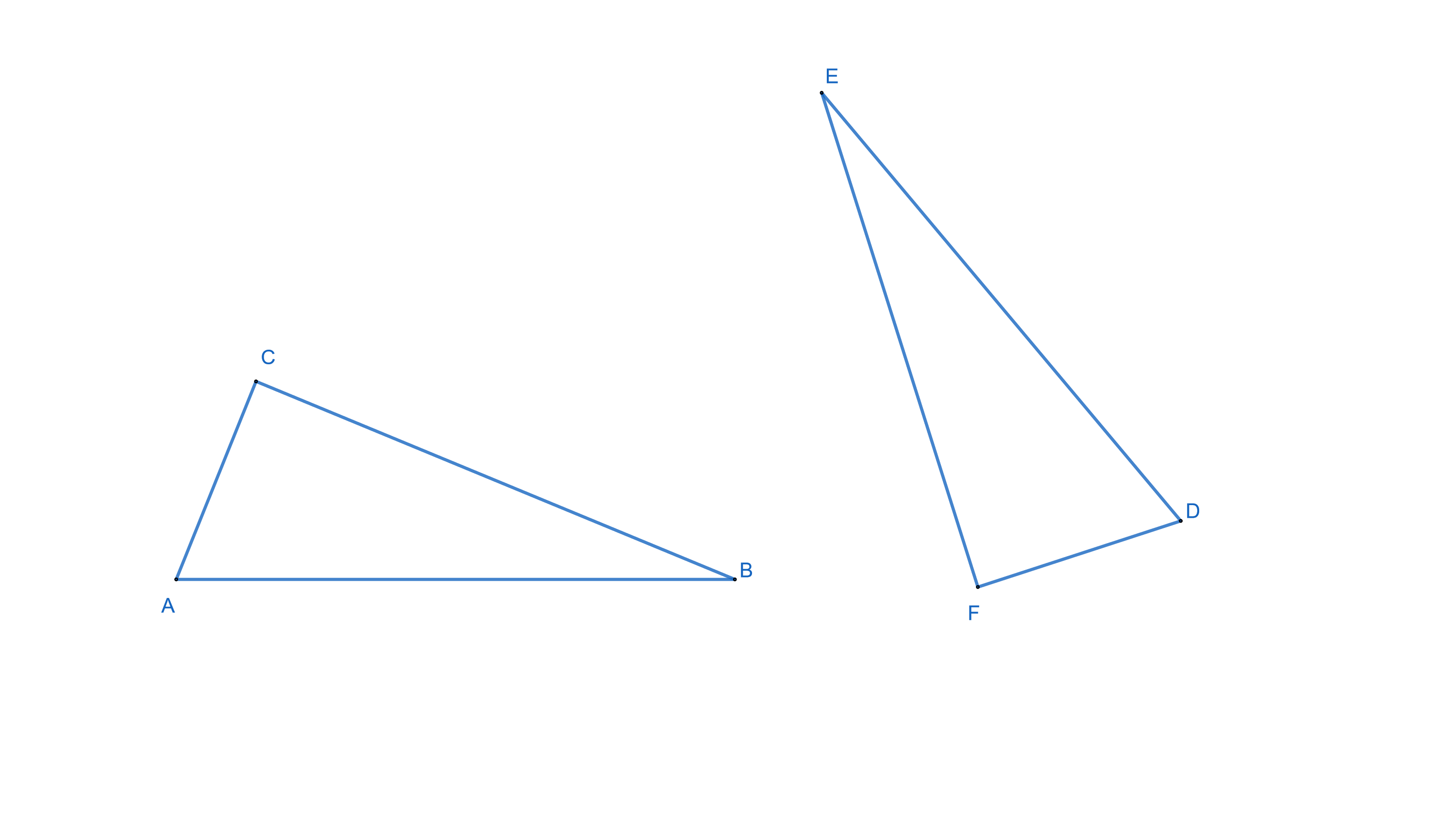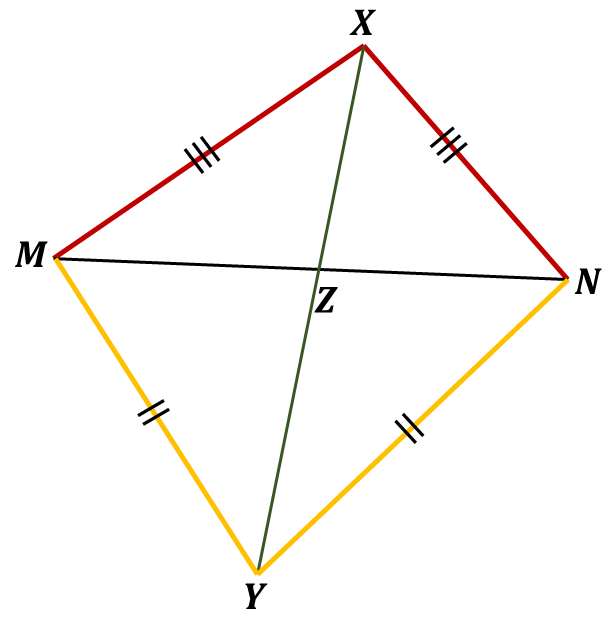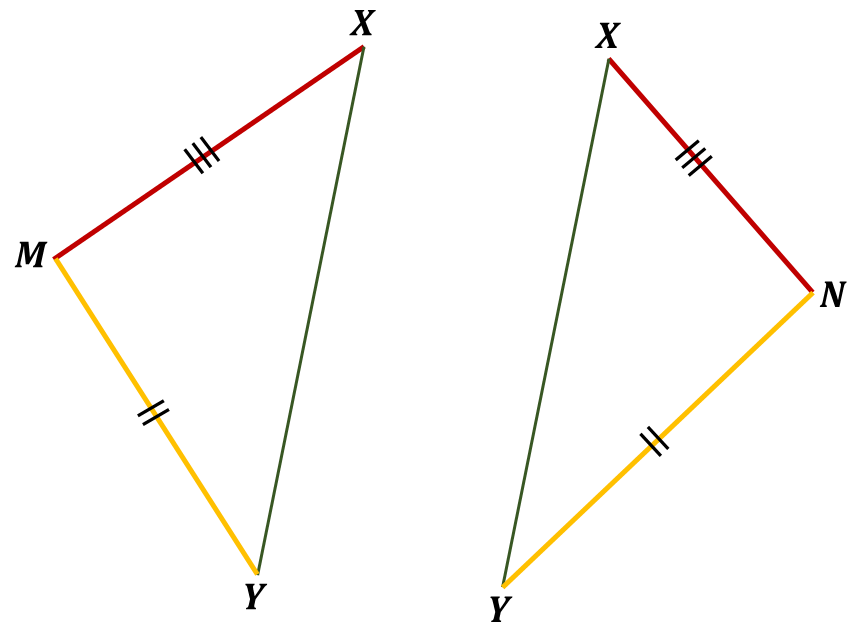In this case – shortcuts to tell if two or more triangles are congruent or not. For this reason, five shortcuts or theorems have been introduced and abbreviated, which makes them easier to remember: SSS, SAS, HL, ASA and AAS. In this article, only the first two will be explained. More on the rest in the another article.
If you can spot only one of the following conditions between two or more triangles, then this means that the triangles are congruent to each other.
What is SSS?
Side-Side-Side or SSS for short is pretty simple to understand.
SSS theorem means that all three corresponding sides are equal between two or more triangles, which means that all corresponding angles are therefore equal too.
So if you spot SSS, think of congruency.
Let’s look at some SSS examples.
Two equilateral triangles are positioned next to each other. If you don’t know what is an equilateral triangle, this simply means a triangle with all equal sides.
Are these two triangles congruent?
 Two equilateral triangles - StudySmarter Original
Two equilateral triangles - StudySmarter Original
So, by mere observation, it can be seen that both equilaterals are indeed the same (equal) in both length and angle.
This is a great case to apply the SSS theorem to prove congruence. So, Side-Side-Side – all three respective sides are equal between these triangles. You can look at the picture above to understand this better. We can say that the first triangle is congruent to the second triangle:
Triangle_1 ≅ Triangle_2
The example above is a simple case because you don’t even need to look if the given sides are equal correspondingly, that is, whether the sides of one triangle are equal to the respective sides of the other triangle.
Why is this important? You can position the triangles in any way relative to each other and it will still be easy to tell that they are congruent, because all sides have the same length.
So let’s look at a case where it’s important to take into account the order in which we compare the sides of one triangle and the other in the next example.
Here are two triangles positioned differently from one another - one triangle is rotated relative to the other. Are these triangles congruent?

Differently oriented triangles - StudySmarter Original
By looking at the lengths of the sides of both triangles it is evident that the given triangles are congruent given the theorem SSS:
ABC ≅ DEF
In this example, the order of the letters also shows that the sides of one triangle are equal to the respective sides of the other triangle. ABC and DEF are arranged alphabetically and the respective sides AB, BC, CA are equal in length to DE, EF, FD consecutively. It’s not so evident when looking at the picture above, though. If there were no letters naming the triangles, you’d need to first understand that the triangles are rotated relative to each other.
Keep in mind that this may not always be the case as in the example above – in some cases, the names of the triangles are not matched alphabetically or arranged logically, but the triangles can still be congruent. Always look at how the triangles are positioned relative to one another first. The names of the triangles are arbitrary.
In the figure below, the line XY is equidistant to the line MN. Is the triangle YMX congruent with triangle YNX?
 Image 1 of congruent triangles formed from equidistant lines - StudySmarter Original
Image 1 of congruent triangles formed from equidistant lines - StudySmarter Original
Solution
The line XY being equidistant to line MN means it cuts MN at its midpoint. This implies that;

Image 2 of congruent triangles formed from equidistant lines - StudySmarter OriginalNow, both triangles YMX and YNX have the same third side XY.

Image 3 of congruent triangles formed from equidistant lines - StudySmarter OriginalTherefore;
Let’s move on to the next theorem called SAS.
What is SAS?
Side-Angle-Side or SAS for short means that two corresponding sides together with the joining angle are equal between two or more triangles.
SAS is true because the length of the third side is pre-determined if the length of the remaining two sides and the angle they form is known. If two or more triangles have two equal sides with the same exact angle in between them, this means the given triangles are congruent.
Let’s look at a couple of examples of SAS.
Two triangles are given next to each other. The first triangle has one angle of 60º and the two sides forming it have both a length of 6. Same case with the second triangle. Are these triangles congruent?
 Triangles with equal angles and respective sides - StudySmarter Original
Triangles with equal angles and respective sides - StudySmarter Original
You may think this is pretty easy, huh? Pretty trivial maybe?
That’s right! Just by looking at the picture, you can tell this is the same case as the first example of SSS, only the sides are of different lengths. In this case, however, the given info on the triangles is only of the lengths of two sides and the angle in between. If you already know equilateral triangles well, you can tell they are both congruent right away even without the picture.
If taking into account only the given info, the triangles in this example are congruent given the condition SAS:
Triangle_1 ≅ Triangle_2
Let’s try a bit more complex case.
Three triangles are positioned differently from each other. See the picture below.
 Differently positioned triangles - StudySmarter Original
Differently positioned triangles - StudySmarter Original
Are these triangles congruent?
You can see that the triangles are all rotated relative to each other. By looking at the given values on the triangles, we can see that ABC is not congruent to DEF because the angles between the corresponding equal sides AB, BC and DE, FE are not equal. However, ABC and XYZ are congruent due to the theorem SAS, because they both have equal respective sides and the angle formed by them is also the same:
ABC ≅ XYZ
Remember that triangle names are arbitrary and in some cases, the names of the triangles are not matched alphabetically or arranged logically. This is the case in the example above, but ABC and XYZ are still congruent due to SAS.
Let's go to further examples.
Let us go through an example to understand better what SAS and SSS mean as well as to observe the distinction between both.
 An image showing three diagrams of that portrays the SSS and SAS theorems - StudySmarter Original
An image showing three diagrams of that portrays the SSS and SAS theorems - StudySmarter Original
The figure below consists of three diagrams labelled I, II and III. Determine the following:
a) Are they all congruent?
b) Which is (are) SSS congruent?
c) Which is (are) SAS congruent?
d) If the area of the ΔMON is 60m2 , ∠PRQ is 60° and line PR is 10m find QR.
Solution
a) From the figure above, diagram I have both triangles joined together have two of their sides and angle equal. Thus, with respect to the SAS theorem, we can say both triangles in I are congruent.
In diagram II, all three sides of both angles are the same; thus, in line with the SSS theorem, both triangles in diagram II are congruent.
In diagram III, both triangles have two of their sides and angle equal. Thus, with respect to the SAS theorem, we can say both triangles in III are congruent.
b) Based on the earlier solution from question a), we can say that only diagram II is SSS congruent.
c) Based on the earlier solution from question a), we can say that both diagrams I and III are SAS congruent.
d) Since triangles MON and PQR are SAS congruent, i.e.;
Then;
To find line QR when PR is given, we know that;
Make line QR the subject of the formula by dividing both sides of the equation by the product of 10m and cos60° to get;
Remember that
Therefore,
SSS and SAS - Key takeaways
- There are five theorems for triangle congruence, which help to evaluate whether given triangles are congruent.
- These theorems are SSS, SAS, HL, ASA and AAS;
SSS (Side-Side-Side) states that two or more triangles are congruent if all of their respective sides are equal;
SAS (Side-Angle-Side) states that two or more triangles are congruent if two consecutive sides are equal to that of another triangle and the respective sides form the same exact angle.















